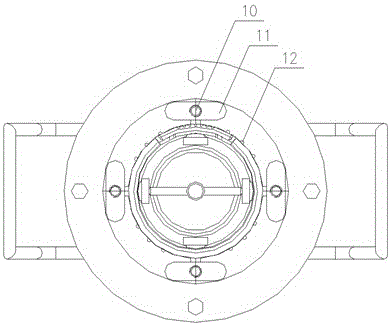Pouring method for pouring molding of special-shaped coil former
A technology for infusion molding and special-shaped coils, applied in the field of infusion and infusion molding of special-shaped coil bobbins, can solve problems such as difficulty in infusion molding of special-shaped coil bobbins, and achieve the effect of ensuring integrity, infusion quality and smooth surface.
- Summary
- Abstract
- Description
- Claims
- Application Information
AI Technical Summary
Problems solved by technology
Method used
Image
Examples
Embodiment 1
[0031] A perfusion method for perfusion forming a special-shaped coil skeleton, characterized in that: the method specifically includes the following steps:
[0032] Step 1, pretreat the adhesive, and degas the adhesive by means of agitation and pressure drop, that is, alternately vacuumize and normal pressure;
[0033] Step 2, install the workpiece, take out the four positioning modules 2 of the molding tool, apply a thin layer of grease to all parts that can touch the adhesive, and check the first glue hole 8 and the second glue hole of the molding tool The smoothness of holes 9 and exhaust holes 12; place the unencapsulated coil bobbin 18 at the center of the molding tooling, wrap the coil bobbin 18 with four positioning modules 2 and initially position it; place the four positioning modules 2 through the pressure ring 4 Compaction and close contact; use four rubber plugs 7 to block the central hole of the coil skeleton; seal the connection between the top of the coil skele...
Embodiment 2
[0036] A perfusion method for perfusion molding of a special-shaped coil skeleton, specifically comprising the following steps:
[0037] Step 1, pretreat the adhesive, and degas the adhesive by means of agitation and pressure drop, that is, alternately vacuumize and normal pressure;
[0038] The specific steps of alternately carrying out vacuuming and normal pressure are as follows: first, place the adhesive under the electric mixer in the vacuum box, and use a lifting platform to place the stirring rod in the material box containing the adhesive; Stir the adhesive for 2 to 5 minutes, then pump the pressure to 0.05 to 0.06 MPa, keep it for 1 to 4 minutes, and slowly lower it to normal pressure. After the extracted air bubbles subside, continue to vacuum and stir slowly. Repeat this process. The adhesive is defoamed; finally, put the stirred adhesive into a high-temperature box and keep it warm for 10-15 minutes at a temperature of 40-70°C, and wait for potting. The adhesive i...
Embodiment 3
[0047] On the basis of Example 2, the adhesive is composed of components A, B and C in a mass ratio of 50: (1-5): (5-8); the A Components are liquid polysulfide rubber with a molecular weight of 1200-3000 and liquid epoxy resin mixed at a mass ratio of 1:1; component B is triethylenetetramine; component C is silicon micropowder of 1200-2000 mesh.
[0048] The preparation method of adhesive is:
[0049] 1) Weigh components A, B and C according to the mass ratio of 50:(1-5):(5-8);
[0050] 2) After mixing the components A and B of the formula amount evenly, a mixed solution is formed;
[0051] 3) Add the formula amount of component C to the mixture in step 2), and stir evenly.
[0052] The adhesive of the invention adopted can ensure the bonding effect, and meanwhile, the fluidity of the adhesive is optimal.
PUM
| Property | Measurement | Unit |
|---|---|---|
| thickness | aaaaa | aaaaa |
Abstract
Description
Claims
Application Information
 Login to View More
Login to View More - R&D
- Intellectual Property
- Life Sciences
- Materials
- Tech Scout
- Unparalleled Data Quality
- Higher Quality Content
- 60% Fewer Hallucinations
Browse by: Latest US Patents, China's latest patents, Technical Efficacy Thesaurus, Application Domain, Technology Topic, Popular Technical Reports.
© 2025 PatSnap. All rights reserved.Legal|Privacy policy|Modern Slavery Act Transparency Statement|Sitemap|About US| Contact US: help@patsnap.com



